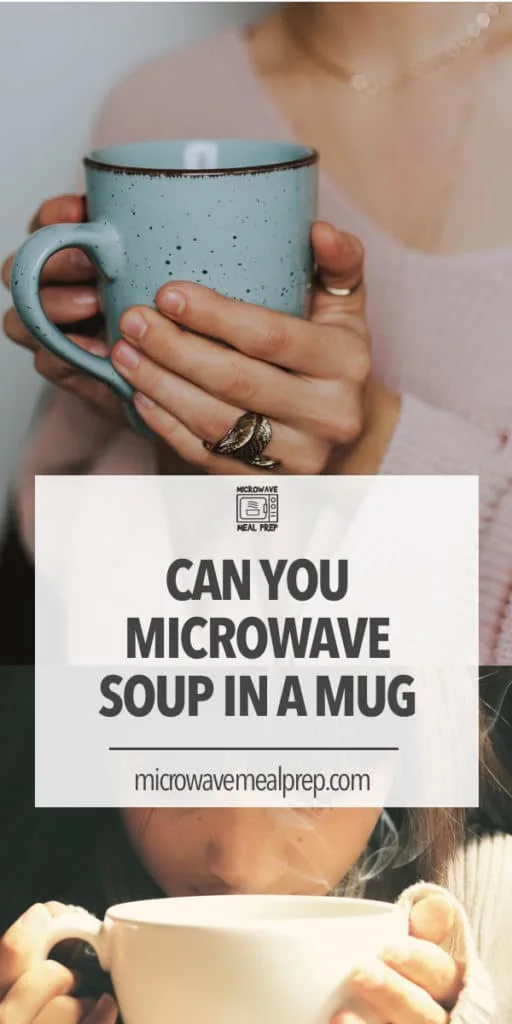Is it safe to reheat soup in a cup? How do you use microwave mug soup? What is the best way to microwave soup in a cup?
Yes, soup can be reheated in a mug. A regular coffee mug doesn’t allow for the same amount of surface area as a large bowl, but in a pinch it works as a viable option.
Exercise caution when using a mug to reheat soup. Air pockets can trap steam underneath the surface in a superheating effect, which can cause soup to explode in the microwave.
It’s best to leave a wooden stirring spoon, skewer or chopstick inside the mug to breakup the surface tension that traps steam underneath. Furthermore, you can use the stick to stir the soup and make sure that it is heated evenly.
Microwave safe cups and mugs are a much better choice than to go soup containers. So if you’re in a squeeze, then consider using containers that a safe for microwave use over riskier alternatives.
Best way to reheat soup in a mug
Microwaving soup in a mug may be a quick fix that you have to occasionally resort to. However, it can be messy and dangerous if done improperly.
Use caution when you microwave soup. Here is an easy way to safely reheat soup in a cup.
- Use a microwave-safe cup or mug. Glass or ceramic mugs work best, but you can use anything labeled “safe for use in microwave.”
- Heat uncovered. Never heat foods in the microwave with an airtight lid or snap locking cover.
- Place cup of soup in center of microwave. The center of the microwave is the focal point. Center the food to heat rapidly and more evenly.
- Leave a non-metallic object inside the soup. A wooden chopstick, popsicle stick or skewer will break tension on the surface, which helps prevent a superheating explosion.
- Heat soup in 30-second intervals. A cup and mug has a small surface area. Carefully stir the soup after each 30-second duration to promote even heating.
- Cautiously tap the mug to check for superheating. Jostle the side of the container with a stick or spoon to disturb the surface tension of the mug. The soup may explode out of the cup if it was superheated and the surface tension is broken.
- Carefully remove the mug. Use hot mitts to avoid burns from the hot cup or soup splashing out of the narrow container.
Leftover soup is considered a potential food safety hazard, and the USDA recommends that all soup be reheated to 165 °F. However, achieving this high temperature may be challenging in a mug. Frequent stirring is going to be the best way to achieve the right temperature inside a small container like a cup or mug.

Things to know before reheating soup in a cup
Reheating soup on the stovetop is recommended over using a cup or mug to reheat soup in the microwave. It’s understandable that you may not want to dirty the stove or any pots and pans in the process.
Use caution because soup can explode in the microwave, especially when heated in a cup or mug. So exercise caution and be sure to follow the instructions provided by the manufacturer of your specific microwave.
If you choose to follow through with it, here are a few extra precautions to take when you microwave soup in a mug:
- Disposable cups or mugs are not designed to heat food in the microwave unless labeled “safe for microwave use.”
- Never place an empty cup or mug in the microwave without any soup. The cup may overheat and explode without having any liquid to absorb the microwave’s energy.
- Confirm the cup or mug does not contain any metal parts. Metal is not safe to use in the microwave because it may trigger sparks that can damage your appliance.
- Heat in short 30-second intervals and stir frequently to promote even heating.
- Reheat soup to 165 °F in accordance with safe food handling guidelines.
A microwave safe cup or mug is a far better option than using the disposable containers like cup-o-noodles, the to go soup cup provided at the supermarket deli counter or the one from your favorite takeout meal.
However, if microwaving soup is a common practice, then consider investing in a microwave soup bowl. They are the best option when it comes to portion size and container materials that are safe for microwave use.

